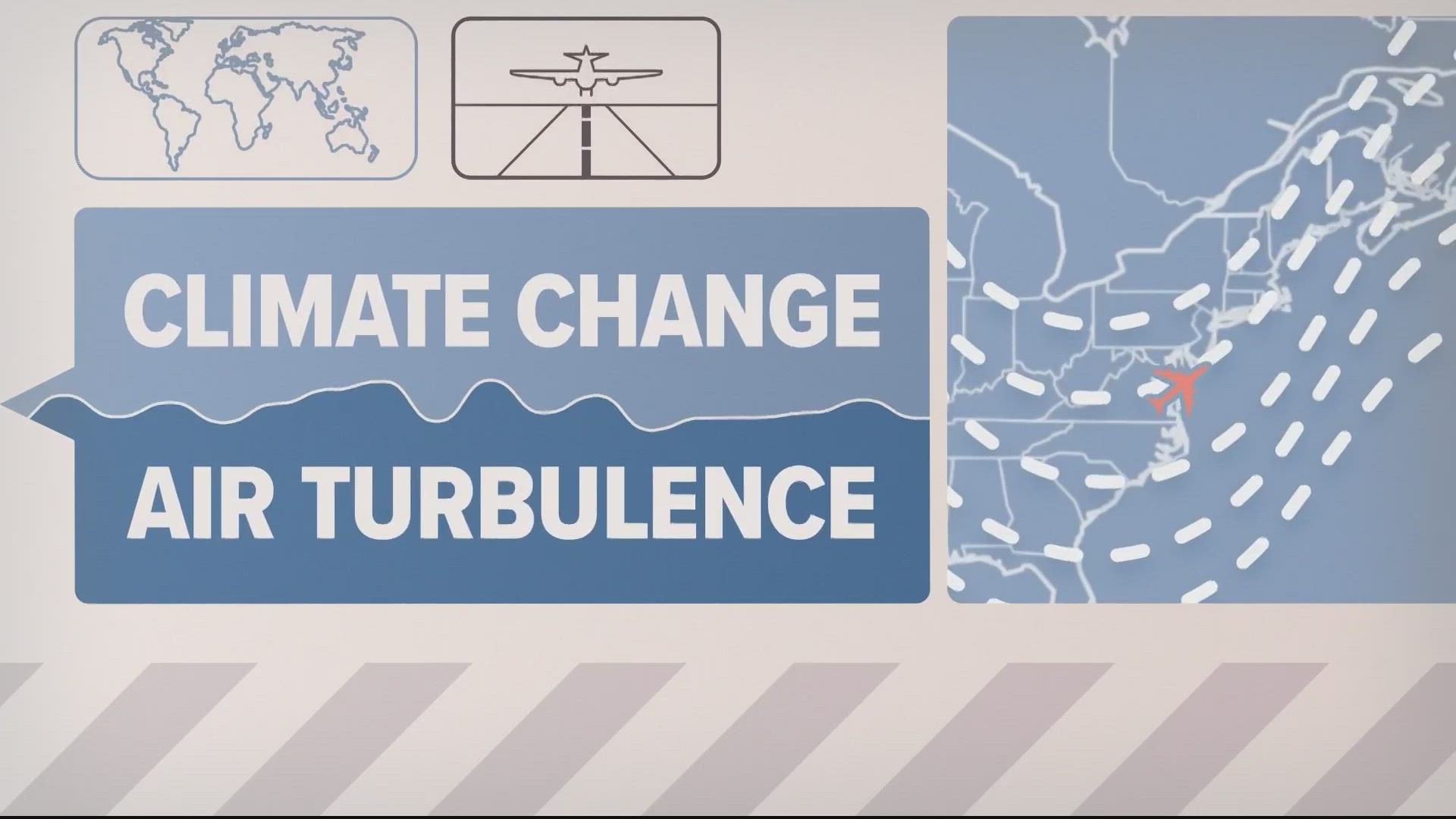WASHINGTON — Chances are, if you're a frequent flier, you've probably experienced a bumpy ride. Turbulence as a result of stormy weather is easy for pilots to detect and fly around but turbulence we can't see is being impacted by climate change.
You can be flying through beautiful blue cloudless skies, when out of nowhere....turbulence hits. It's known as "clear air turbulence" and for good reason - there are no visible signs and it's undetectable on radar and satellite imagery. New research shows that rocky rides are becoming more common and like the turbulence, the link to climate change is clear.
To learn more about the first-of-its-kind research, we hop across the pond to the United Kingdom. Paul Williams is a Professor of Atmospheric Science at the University of Reading who has dedicated more than a decade to researching the answer to a question posed by a colleague, "What is climate change doing to turbulence?"
"I had to confess I had no idea," said Williams. "I had to look through the scientific literature and there was really nothing out there. So it was a complete unknown."


Paul immediately dove into dissecting the connection between climate change and air turbulence and has since found clear evidence for strengthening turbulence across the globe in the jet stream region. It all has to do with a law of atmospheric dynamics called thermal wind balance.
Williams explains, "It tells us that north-south temperature differences are what drives wind shear in the jet stream...vertical wind shear."
Climate change as a result of greenhouse gas emissions is causing temperatures to rise more rapidly in the tropical parts of the planet than in the polar regions in the upper atmosphere. While at the surface, the opposite is occurring and the poles are warning faster than the tropics.
This temperature contrast is leading to strengthening wind shear. Wind shear is the change in wind speed and direction with height which creates turbulence.
Paul and his team of researchers found that the amount of wind shear in the jet stream has increased by 15% since satellites began observing it in the 1970s.
"That is not based on a climate model projection of the future," stresses Williams. "This is something that's already happened in the atmosphere."
He does project that turbulence may become 2 to 3 times worse in upcoming years.
Jim Kinter, a Professor of Climate Dynamics at George Mason University is also forecasting for the future. He specializes in long-term modeling of the atmosphere in our changing climate.
"If we're seeing an increase in clear air turbulence as a result of these changes in the large-scale circulation of the atmosphere," says Kinter. "Then there's the potential for more danger in the future."
Oftentimes, pilots only become aware of clear air turbulence after a fellow pilot has experienced it and radioed the report in.
"We'll need better systems for detecting clear air turbulence," says Kinter. "There are ways to do it, they're expensive and they're only in limited places so it may be quite a challenge."
Researchers are hopeful the newest generation of computer modeling, available in the next 5 years, will be much better at predicting these unpredictable forecast challenges.
"If we had forecasts that could be issued in real-time to pilots as they're in the air," says Kinter. "Then the pilots could get that information and they could take evasive maneuvers or find ways to avoid the bad areas."
So the question remains - Is it safe to fly with turbulence forecast to become worse in the future?
The answer is yes. While flights may become bumpier, commercial airlines are built to withstand turbulence.
The FAA says the biggest risk to passengers and crewmembers comes when they aren't buckled in. To avoid injuries, the FAA suggests the following:
- Listen to the pilots and flight attendants - FAA regulations require passengers to be seated with seat belts fastened whenever the seat belt sign is on during the flight.
- Pay attention to the safety briefing at the beginning of your flight and read the safety card in your seat pocket.
- Use an approved child safety seat or device if your child is under two.
- Prevent inflight injuries by adhering to the airline's carry-on restrictions.
Unfortunately a Montgomery County, Maryland woman did died after a turbulent flight that was diverted to Windsor Locks, Connecticut in early March.
It is unclear what the official cause of death was, and how it relates to the turbulence on the flight.
Officials have identified a woman who died after a turbulent flight that was diverted to Windsor Locks, Connecticut as 55-year-old Dana Hyde of Cabin John, Maryland.

